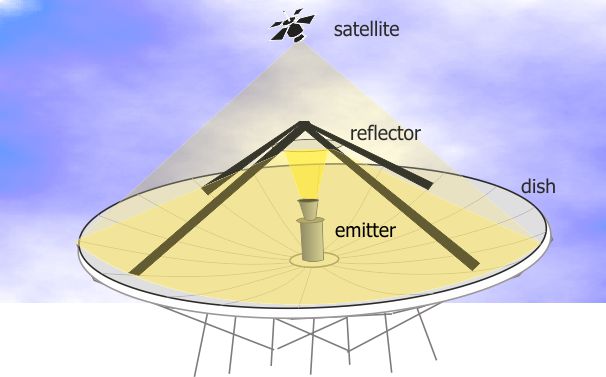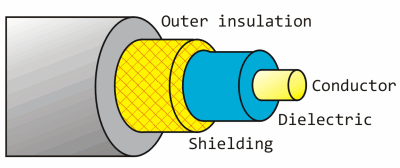Freesat reception - all about dishes
 Brian Butterworth published on UK Free TV
Brian Butterworth published on UK Free TV Satellite reception has both advantages and disadvantages compare with terrestrial (aerial) reception.
By using much higher frequencies (gigahertz, compared to terrestrial televisions megahertz) more transmission channels called transponders (the satellite equivalent of multiplexes) can be provided. For example, there are only six Freeview multiplexes, but Sky or Freesat users can access two hundred satellite transponders.
Aside from exceptional weather conditions (very heavy rain for example) digital satellite provides stable pictures and audio. Where Freeview transmitters are no more than 732 metres above sea level, the geostationary satellites used for television are 35,800,000 metres above the equator so reception is possible even where buildings, trees and hills make terrestrial reception impossible.

The downside of the transmitters being 22,300 miles up in the air is that the signals are very, very weak - so standard TV aerial is of little use. When the signals are sent to the satellites, huge dish transmitters are used to uplink the signal to the satellite. These are tens of metres from side to side, and feature an emitter that generates the signal, which is first bounced of a mirror (called a reflector) and then off the surface of the parabolic dish.

There are many satellites in the sky over the equator. Often these are in clusters over a particular position, for example there are four used for UK television are at 28.2 degrees east. There is another cluster over the 19.2 degrees east positions that are used for German television.
To receive these very weak signals from the satellite, it is necessary to use a dish for reception too. By using a reflective dish, this concentrates the signals onto a small device called a LNB. This is held in front of the dish by a metal arm.

The size of dish for reception is typically much smaller; often 60cm to 100cm in diameter, but the exact size depends upon the transmitting satellite transponder. To keep the transmission power levels down to levels that can be powered by the satellite's solar panels, each beam is focused on a particular area of the Earth's surface. If you are trying to receive the signal at the centre of this zone, a small dish is required. At the outer edges, you may need a 5 metre dish. Maps of these zones are provided by the satellite companies, and are called satellite footprints.
When the dish is installed it must be aligned carefully as the signal is very weak. The installer needs to know the inclination and the azimuth from the ground location to the satellite. If you install yourself you will find that there are markings on the dish that are used to point the dish in the correct position. It is important that the view of the satellite will not be blocked, so must take into account leaves growing on trees and potential building works.
For many people the LNB will have a single cable connected to it, however if you have Sky+ or a multi-room installation the LNB package will actually contain four receivers a quad-LNB. Unlike terrestrial television where you can split the aerial cable to feed more than one Freeview box or television set, with satelite reception you cannot. So, a Sky+ box with two receivers (so you can watch one thing and record another) has two cables connecting the box to the dish.
The cable that connects the dish to the receiver must be satellite grade cable. Whilst this looks superficially like the cable used to connect and aerial to a television, a higher grade cable is required for satellite reception.
Here is an image of a co-axial cable. This sort of cable is used to connect any type of receiving aerial to the reception equipment.

RG6, PF100 and PH100 are all types of coax cable that are suitable for the very weak signals that are received by a satellite dish. (The power is the same as you would receive from a one-bar electric heater on the moon).
The conductor in the centre passes the signals received from the dish to the set-top box. This is made from steel in RG6 cable, and from copper in the RF100 and PH100 types. This makes RG6 less suitable in the UK where rain can damage the cable.
The shielding is responsible for keeping unwanted external interference from damaging the signal. In the cheaper cable this will be a foil wrap, in better specified cables this is a braid (or mesh) of copper wires. The sheild in the RF100 covers 58% of the cable.
The non-conducting layer between the shield and the conductor is called the dielectric. This can be either a solid (RG6), foam (RF100) or air-spaced (PH100) dielectric. This makes the cables progressively more flexible (ie bendy without damage).
9:50 AM
Hi all,
I have a strange issue with my new Freesat set-up.
What currently works:
- Sky dish connected to sky box
- LNB coaxial cable in another room (from the Sky dish) connected to a Freeview-SD box (at the LNB-IN)
What does not work:
- LNB coaxial connected (via LNB-Antenna Female adaptor) to the Antenna-In of a new Freesat Box. I get 'No signal' message on the TV screen.
I also connected the LNB-Antenna-F-adaptor directly to the Antenna-IN of the back of the TV (no box involved), and auto-scanned for signals, but got no signals.
Where could the problem be?
Many thanks to all, in advance.
Sam
| link to this comment |
11:41 AM
Sam Mott Could you confirm that you have at least a dual LNB with a separate cable run to your Freesat box? Each sat tuner requires an LNB connection so e.g. a Sky plus box and a dual tuner freesat box would require a quad LNB and 4 cables. Only TVs or set top boxes with satellite tuners will work with coax connections from LNBs
| link to this comment |
1:31 PM
Neil Bell: Thanks Neil.
I got an engineer to come over last year to connect my Sky dish to 3 rooms. Each room has a coax cable (with a single LNB at the end). He also left me with a fully functional Freeview SD box.
I now like to use the coax cable and connect a Freesat HD. The Freesat box I bough, unfortunately does not have a LNB-IN, but has an Antenna-IN.
Not sure if I can answer your question - bit too complicated for me, but I hope the above information might be helpful?
IF you need me to get you more specific information, just let me know what to look for. Many thanks.
| link to this comment |
2:00 PM
sam mott: Any box with an "Antenna" in socket is a Freeview box intended to be used with a normal aerial, as "all" satellite devices are connected with what's known as an "F" connector that fits into the boxes LNB input socket.
If you have just recently purchased the box and its still in its original "and unmarked" packaging then you may be able to change it for the correct Freesat type.
| link to this comment |
sam mott: You can't use a "Freeview" receiver with a satellite dish.
If you are using an adaptor such as this then you will still not be able to use the Freeview receiver with the dish:
F Type Screw Connector Socket to RF Coax Aerial Male: Amazon.co.uk: Electronics
As jb38 says, a Freeview box is for use with a normal aerial.
| link to this comment |
2:21 PM
jb38: Thank you very much. That explains it.
Aerial antenna -> Antenna-In
Dish -> LNB-IN
Ill have to return it and get the one wit a LNB-IN.
| link to this comment |
3:31 PM
sam mott: Yes, best policy! as a Freeview box is of no use to you unless you had a normal loft or roof aerial installed as well as residing in a reasonably good reception area, but remember that anything you purchase has to have "Freesat" printed on the box and NOT "Freeview", the emphasise being on "sat".
| link to this comment |
4:15 PM
Sam Mott although you do say you have a fully functioning SD Freeview box so presumably you have an aerial and a signal? In which case have you tried replacing the SD box with the new HD box. That would show you definitely if it is a Freeview and not Freesat box. If that works you could try a splitter on your aerial & run a cable from the splitter to the new HD box instead of from the LNB.
| link to this comment |
2:24 PM
Hi
can you tell me if a easy find lmb will work with a humax
receiver
| link to this comment |
2:29 PM
Hi
will a easy find lmb work with a humax receiver
i go away in the caravan a lot
thanks
| link to this comment |